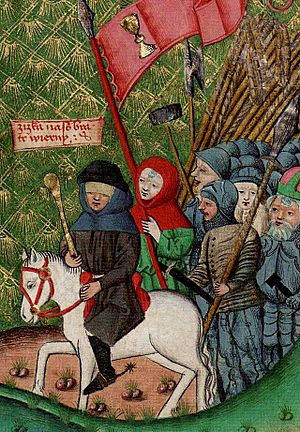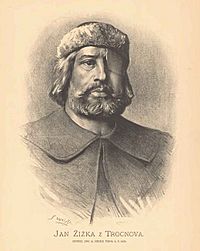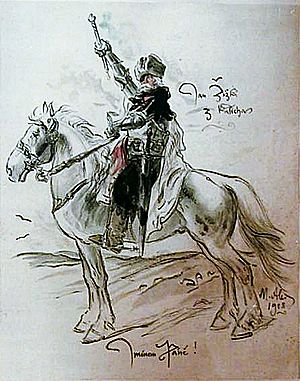Jan Žižka facts for kids
Quick facts for kids
Jan Žižka z Trocnova a Kalicha
|
|
|---|---|
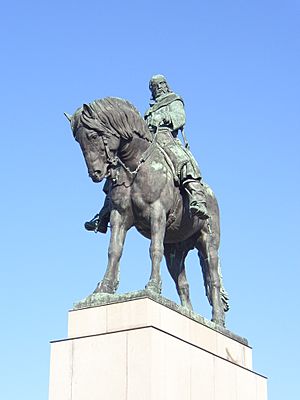
Statue of Jan Žižka by Bohumil Kafka on Vítkov Hill in Prague
|
|
| Nickname(s) | John the One-Eyed Žižka of the Chalice |
| Born | c. 1360 Trocnov, Kingdom of Bohemia |
| Died | 11 October 1424 (aged 63–64) Přibyslav, Kingdom of Bohemia |
| Buried |
Cathedral of the Holy Spirit
|
| Allegiance | Hussites (1419–1423) Taborites (1423–1424) |
| Years of service | c. 1378–1424 |
| Rank | Chamberlain to Queen Sofia of Bavaria |
| Battles/wars | Battle of Grunwald Hussite Wars
|
| Awards | A castle near Litoměřice. He gave the biblical name of Chalice (Kalich in Czech) to this new possession |
Jan Žižka (born around 1360 – died October 11, 1424) was a famous Czech general. He was a follower of Jan Hus, a religious reformer. Žižka led a group called the Taborites, who were part of the Hussites. He was a very successful military leader and is now seen as a national hero in the Czech Republic. People often called him "One-eyed Žižka" because he lost one eye, and later both, in battles.
Žižka was born in a small village called Trocnov in the Kingdom of Bohemia. His family was noble. When he was young, he worked for the royal family. He was a Chamberlain (a high-ranking assistant) to Queen Sofia of Bavaria.
He fought in the Battle of Grunwald in 1410. Later, he became very important in the Hussite Wars, which were civil wars in Bohemia. In the Battle of Kutná Hora (1421), he defeated a large army from the Holy Roman Empire and the Hungarian Kingdom. His use of cannons on wheels (field artillery) was very effective against enemy cavalry. This made cannons a key part of the Hussite army.
Žižka's fighting methods were new and clever. He trained his army, mostly made of peasants, to fight against highly skilled knights. He used armored wagons with small cannons and muskets, which were like early versions of tanks. He also used the land to his advantage and kept his soldiers well-disciplined.
A large monument stands on Vítkov Hill in Prague to honor Jan Žižka. It celebrates his victory there in 1420. This monument includes the third largest bronze statue of a person on a horse in the world.
Contents
The Battle of Grunwald
Žižka was on the winning side of the Battle of Grunwald. This was one of the biggest battles in Medieval Europe. It happened on July 15, 1410, during a war between Poland, Lithuania, and the Teutonic Knights. The armies of Poland and the Grand Duchy of Lithuania joined forces. They were led by King Władysław II Jagiełło and Grand Duke Vytautas. They completely defeated the Teutonic Knights.
Many of the Knights' leaders were killed or captured. The Knights never got back their old power after this battle. The cost of the war also caused problems and a downturn in their lands. This battle changed who had power in Eastern Europe.
Becoming a Leader
Žižka became the main military leader of the Hussites during the Hussite Wars. The Hussites were a Christian group who followed the teachings of Jan Hus. Hus was a Czech priest and reformer. He taught at Charles University in Prague.
In November 1419, a temporary peace was made between the king's supporters and the people of Prague. Žižka did not agree with this peace. He left Prague with his followers and went to Plzeň. He soon left Plzeň too. On March 25, 1420, he defeated the king's supporters at Sudoměř. This was the first major battle of the Hussite wars.
Later, he arrived at Tábor. This was a new stronghold for the Hussite movement. Tábor had a very strict military system, but its government was democratic. Žižka helped a lot in setting up this new military community. He became one of the four main captains, called hejtman.
Wagon Fort Tactics
Žižka helped create a special way of fighting using wagon forts. These were called vozová hradba in Czech or Wagenburg in German. They were like mobile forts. When the Hussite army faced a bigger enemy, they would arrange their wagons into squares or circles. The wagons were connected wheel to wheel with chains. They were placed at an angle so horses could be quickly attached if needed.
In front of this wagon wall, the Hussites would dig a ditch. Each wagon had 16 to 22 soldiers. These included crossbowmen, handgunners, soldiers with pikes or flails (the flail was a special Hussite weapon), shield carriers, and drivers.
Hussite battles had two parts. First, they defended. They placed the wagons near the enemy and used cannons to make the enemy attack. The cannons caused many injuries from close range.
To avoid more losses, the enemy knights would charge. The Hussite soldiers, hidden behind the wagons, used firearms and crossbows to stop the attack. They aimed at the horses first to make the cavalry less effective. Many knights fell when their horses were shot.
When the enemy was weakened, the second part began: a counterattack. Hussite foot soldiers and cavalry rushed out from behind the wagons. They attacked the enemy fiercely, often from the sides. The enemy was caught between attacks from the sides and cannon fire from the wagons. They had to retreat, leaving behind knights in heavy armor who could not escape. The enemy armies lost many soldiers. The Hussites became known for not taking prisoners.
Gunpowder Weapons
The Hussite Wars were also important for the first successful use of pistols in battle. Žižka was very good at using gunpowder weapons. He was the first European commander to move cannons of medium size on carts between his wagons during a battle.
The Czechs called their handguns píšťala, which is where the English word "pistol" comes from. They called their anti-infantry field guns houfnice, which led to the English word "howitzer". At this time, Germans had just started making gunpowder better for smaller, tactical weapons.
A soldier with only a single-shot handgun on an open field could not easily defeat a charging knight. But from behind a castle wall or inside a wagon fort, many trained gunmen could use handguns very well. From his experience at the Battle of Grunwald, Žižka knew how his enemies would attack. He found new ways to defeat armies that were much larger than his own.
Hussite Crusades
The Hussite Wars were fought to gain acceptance for the Hussite faith. This movement was a step towards the Protestant Reformation. It was mainly about religion, but it also involved social issues and made Czech people feel more united. The Catholic Church believed Jan Hus's teachings were wrong. He was removed from the church in 1411 and later burned at the stake in 1415.
The wars started in July 1419. Protesting Hussites threw town councilors out of windows in Prague. This event is called the First Defenestration of Prague. It is said that King Wenceslaus IV was so shocked by this that he died soon after. This led to the armed conflict where Žižka became famous.
The First Anti-Hussite Crusade
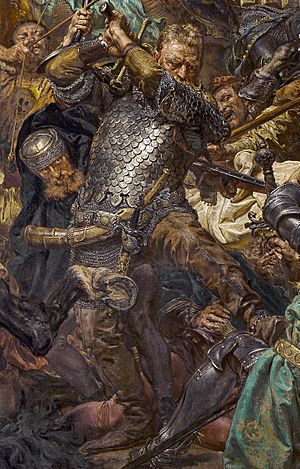
King Sigismund was the king of Hungary. He also claimed the throne of Bohemia. Sigismund was a strong supporter of the Catholic Church. He got help from Pope Martin V. The Pope ordered a crusade (a religious war) in March 1420. This crusade was meant to destroy the Hussites and other groups in Bohemia.
Sigismund and many German princes arrived at Prague on June 30 with a huge army. This army included many adventurers hoping to loot the city. They immediately started to attack Prague. Žižka had to defend the kingdom. He was very practical in his war plans. His army was made up of farmers and peasants. They did not have money or equipment for traditional soldiers like swords, horses, and armor. So, Žižka used their farming skills to make them better soldiers. He turned farm tools into weapons. For example, the farm tool called a flail became a weapon.
The people of Prague asked the Taborites for help against Sigismund. Žižka and his captains led the Taborites to defend the capital. In Prague, Žižka and his men took a strong position on a hill called Vítkov. This hill is now in a part of Prague called Žižkov, named after the battle. On July 14, Sigismund's armies attacked. A strong German force attacked the Vítkov hill, which was important for the Hussites to communicate with the countryside. Thanks to Žižka's leadership, the attack was pushed back. Sigismund's forces stopped their attack on the city.
On August 22, the Taborites left Prague and went back to Tábor. Even though Sigismund had left Prague, his troops still held the castles of Vyšehrad and Hradčany. The people of Prague attacked Vyšehrad. By the end of October, the soldiers inside were about to surrender because they were starving. Sigismund tried to help the fortress, but the Hussites defeated him on November 1. The castles of Vyšehrad and Hradčany then surrendered. Soon after, almost all of Bohemia was controlled by the Hussites.
Žižka then fought many battles against Sigismund's supporters. Through these fights, the Hussites gained control of most of Bohemia. Žižka captured and rebuilt a small castle near Litoměřice. He kept this castle as his only reward. He named it Chalice (Kalich in Czech), following a Hussite tradition. From then on, he signed his name as Žižka of the Chalice. Žižka did not take any more property for himself during the Hussite Wars. This was unusual for the time and showed how different Žižka was from other leaders.
Later that year, he was badly hurt while attacking the castle of Rábí. He lost the use of his remaining eye, becoming completely blind. Even though he was blind, he continued to lead the Taborite armies.
The Second Anti-Hussite Crusade
At the end of 1421, Sigismund tried again to take over Bohemia. He captured the important town of Kutná Hora. The German citizens of the city killed some Hussites and closed the city to Žižka's army. Sigismund's armies arrived and surrounded the Hussites. Žižka was leading the combined armies of Tábor and Prague. Even though he was trapped, he managed to perform what some historians call the first mobile artillery maneuver in history.
Žižka broke through the enemy lines and retreated to Kolín. After getting more soldiers, he attacked and defeated Sigismund's army on January 6, 1422. Sigismund lost 12,000 men and barely escaped. Sigismund's forces made a final stand at Německý Brod on January 10. But the Czechs stormed the city. Against Žižka's orders, the city's defenders were killed.
Civil War
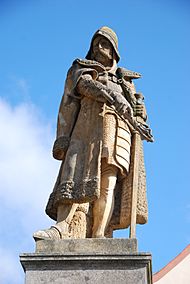
In early 1423, disagreements among the Hussites led to a civil war. Žižka, as the leader of the Taborites, defeated the people of Prague and other nobles at Hořice on April 20. Soon after, news came that a new crusade against Bohemia was being planned. This made the Hussites agree to a temporary peace on June 24.
Once the crusaders left, the internal fighting started again. During his time ruling Bohemia, Prince Sigismund Korybut of Lithuania had appointed Bořek as governor of Hradec Králové. Bořek belonged to a more moderate Hussite group. After Prince Sigismund Korybut left, Hradec Králové refused to accept Bořek as their ruler. They asked Žižka for help. He agreed and defeated Bořek's forces near Hradec Králové on August 4, 1423.
Žižka then tried to invade Hungary, which was ruled by his old enemy, King Sigismund. This campaign in Hungary was not successful because the Hungarians were much stronger. However, it is still considered one of Žižka's greatest military achievements because of his skillful retreat.
In 1424, civil war broke out again in Bohemia. Žižka decisively defeated the "Praguers" and other nobles at Skalice on January 6, and at Malešov on June 7. In September, he marched on Prague. On September 14, the Hussite groups made peace through the influence of John of Rokycany. They agreed that the reunited Hussites would attack Moravia, which was still held by Sigismund's supporters. Žižka was chosen to lead this campaign.
However, Žižka died of the plague at Přibyslav on October 11, 1424, near the Moravian border. A writer named Piccolomini said that Žižka's dying wish was for his skin to be used to make drums. This way, he could still lead his troops even after death. Žižka was so respected that when he died, his soldiers called themselves the Orphans (sirotci). They felt like they had lost their father. His enemies said, "The one whom no human hand could destroy was ended by the finger of God."
Prokop the Great took over as leader after Žižka.
See also
 In Spanish: Jan Žižka para niños
In Spanish: Jan Žižka para niños


